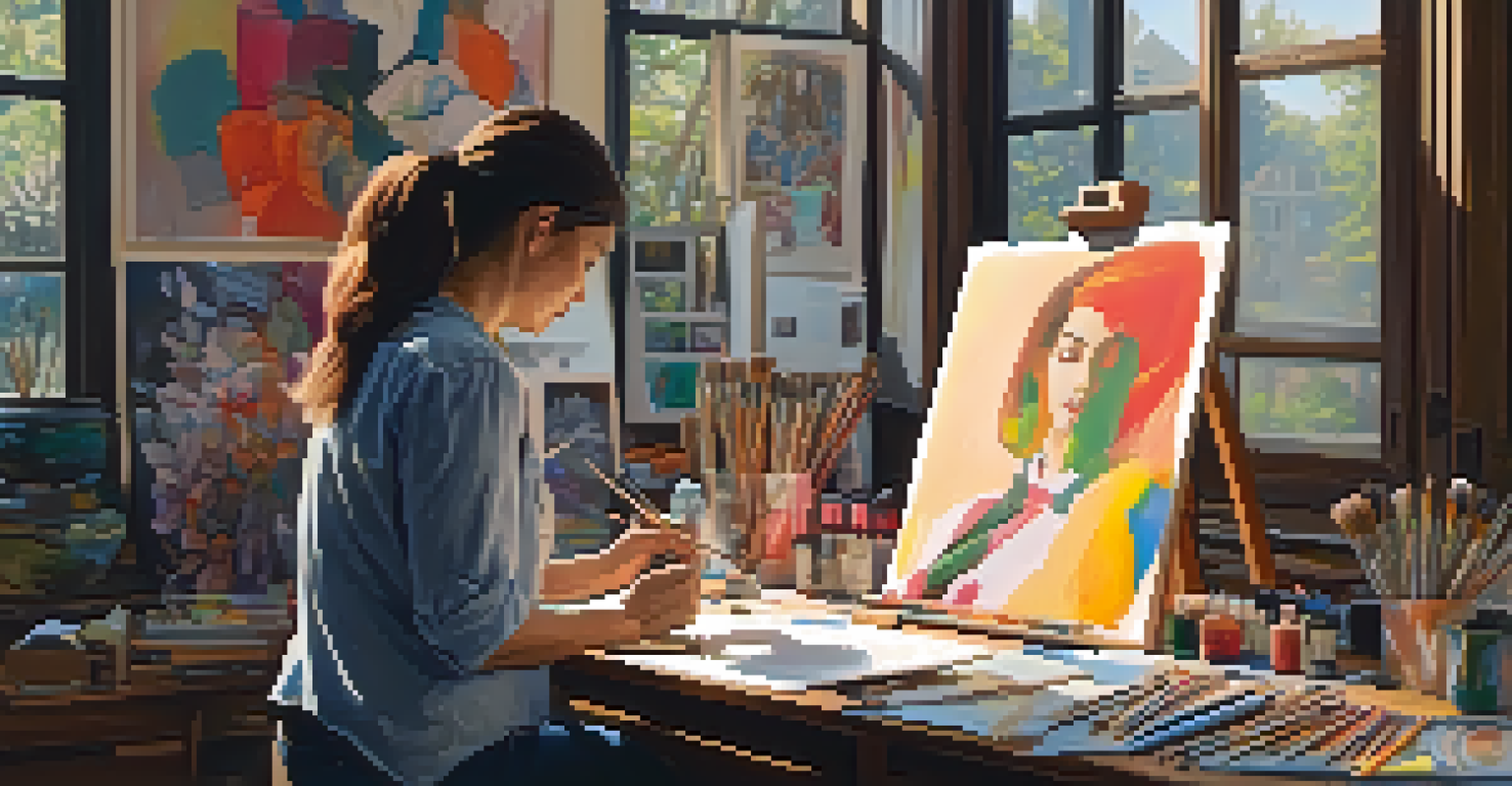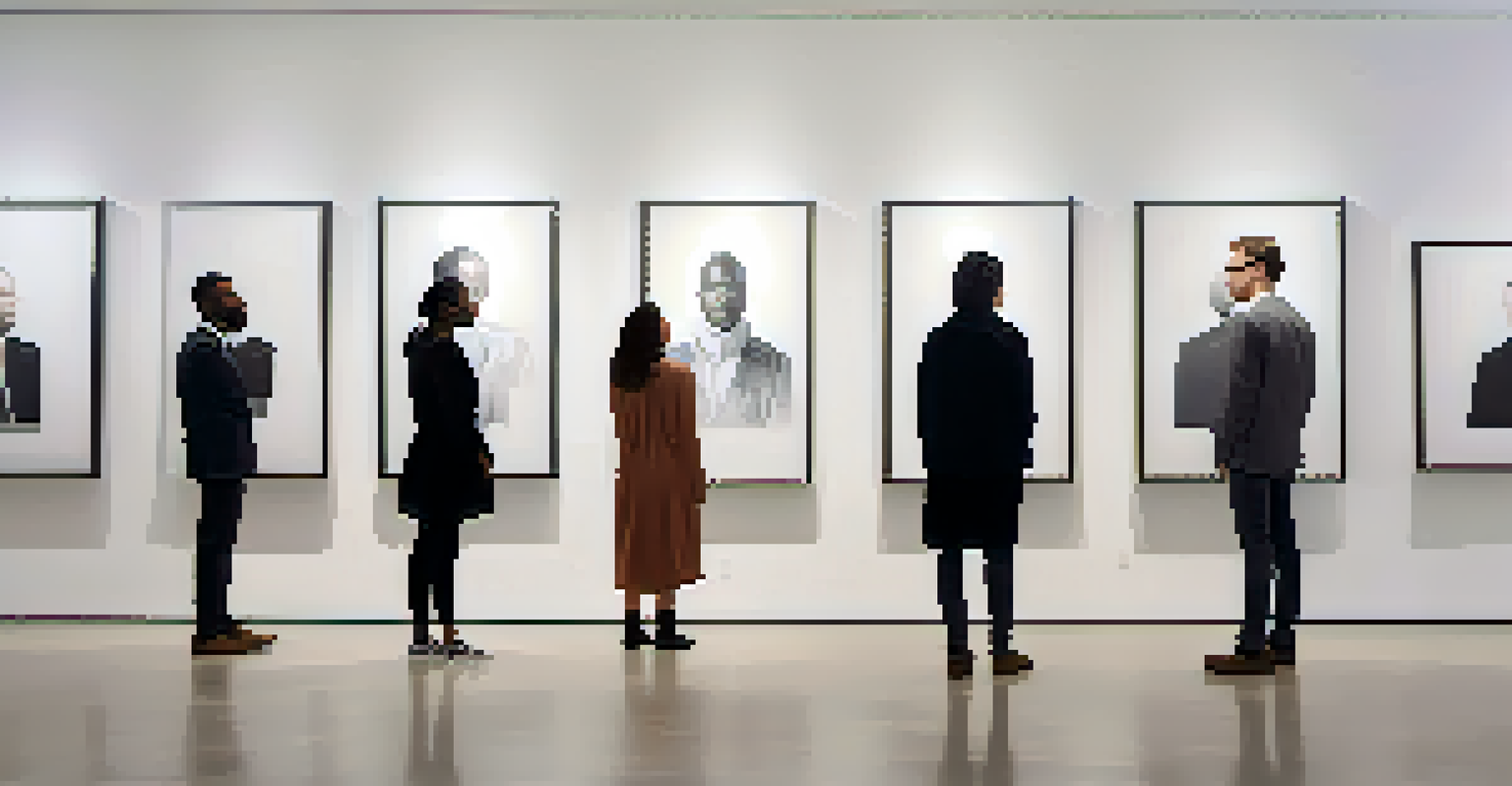Historical Context of Identity Politics in Visual Arts Today

Defining Identity Politics in the Visual Arts
Identity politics refers to the ways in which people's politics are shaped by aspects of their identities, such as race, gender, sexuality, and culture. In the context of visual arts, artists often use their work to express personal and collective identities, creating a dialogue around social issues. This approach allows for diverse voices to be heard, challenging traditional narratives and promoting inclusivity.
Art is not a mirror held up to reality, but a hammer with which to shape it.
For instance, artists like Kehinde Wiley and Frida Kahlo use their own identities to explore themes of representation and heritage. Wiley's vibrant portraits of Black individuals recontextualize traditional European art forms, while Kahlo's self-portraits delve into her Mexican identity and personal struggles. These works encourage viewers to reflect on their own identities and the broader societal frameworks that shape them.
As identity politics continues to evolve, it becomes increasingly relevant in discussions about who gets to tell a story and how those stories are visually represented. By understanding these dynamics, we can appreciate the rich tapestry of voices within the contemporary art scene and the impact they have on cultural discourse.
Historical Roots of Identity Politics in Art
The roots of identity politics in visual arts can be traced back to various social movements, particularly those of the 20th century. The Civil Rights Movement, Feminist Movement, and LGBTQ+ rights movements played pivotal roles in shaping artists' responses to societal norms. These movements emphasized the importance of representing marginalized voices, which laid the groundwork for future generations of artists.

During the 1960s and 70s, artists began to challenge the status quo by incorporating political themes into their work. For example, the Guerrilla Girls used provocative posters and performances to highlight gender inequality in the art world. Their work not only raised awareness but also inspired a wave of activism among artists who sought to address identity and representation issues.
Identity Politics Shapes Art
Artists use their identities to create works that challenge traditional narratives and promote inclusivity.
Over the decades, this historical context has led to a richer understanding of how personal experiences shape artistic expression. The continued exploration of identity in visual arts not only reflects societal changes but also serves as a catalyst for ongoing conversations about equity and representation.
The Impact of Feminism on Identity Politics in Art
Feminism has had a profound influence on identity politics within visual arts, pushing for greater representation of women and their experiences. Artists like Judy Chicago and Cindy Sherman challenged traditional gender roles and highlighted the complexities of female identity through their work. Their contributions have opened doors for future artists to explore feminist themes in innovative ways.
The role of the artist is to make the revolution irresistible.
The feminist art movement of the 1970s was crucial in bringing attention to the underrepresentation of women in the art world. By creating platforms for female artists, the movement encouraged a reevaluation of how women's identities were portrayed in art. This shift paved the way for a more inclusive understanding of what constitutes valid artistic expression.
Today, feminist perspectives continue to influence contemporary artists, who integrate intersectional approaches that consider race, sexuality, and class. This evolution enriches the dialogue around identity politics, allowing for a more nuanced exploration of the ways these identities intersect and impact artistic expression.
Race and Representation in Visual Arts
Race plays a significant role in identity politics within the visual arts, influencing both the artists who create and the audiences who engage with their work. Historically, artists of color have often faced barriers to recognition and representation, leading to a call for greater visibility in the art world. This has prompted a reassessment of how racial identity shapes artistic narratives.
Contemporary artists like Carrie Mae Weems and Ai Weiwei address issues of race and identity through their compelling works. Weems’ photography examines the African American experience, while Weiwei’s installations challenge notions of cultural identity and political freedom. These artists not only highlight the importance of representation but also encourage broader conversations about societal norms and biases.
Feminism's Impact on Art
The feminist movement has significantly influenced representation in visual arts, opening doors for diverse explorations of female identity.
As discussions around race continue to evolve, so too does the role of visual arts in reflecting these changes. The increasing emphasis on diverse perspectives is reshaping the art world, fostering a more inclusive environment that values the contributions of artists from various racial backgrounds.
LGBTQ+ Art and Identity Politics
The LGBTQ+ community has played a crucial role in the development of identity politics within visual arts, with artists using their work to explore themes of sexuality and gender identity. This movement gained momentum during the late 20th century, particularly in response to the AIDS crisis and rising visibility of queer culture. Artists like David Hockney and Keith Haring used their platforms to advocate for LGBTQ+ rights and challenge societal norms.
As artists began to openly express their identities, they created a space for others to do the same. The work of artists like Tracey Emin and Zanele Muholi not only reflects personal experiences but also addresses broader social issues, fostering understanding and acceptance. Their contributions help to normalize discussions around sexuality and gender, making them more accessible to diverse audiences.
Today, LGBTQ+ artists continue to push boundaries, using their work to celebrate identity while also critiquing societal expectations. This ongoing dialogue not only enriches the visual arts landscape but also serves as a powerful reminder of the importance of representation in shaping cultural narratives.
The Role of Social Media in Identity Politics
Social media has transformed the landscape of visual arts, providing a platform for artists to share their work and engage with audiences worldwide. This shift has democratized art, allowing underrepresented voices to gain visibility and connect with like-minded individuals. As a result, identity politics has found new life in the digital realm, where artists can express their unique perspectives and experiences.
Platforms like Instagram and TikTok have become crucial for artists to showcase their work and build communities around shared identities. For example, hashtags related to specific identities or movements can amplify voices that might otherwise go unheard. This digital space fosters a sense of belonging and encourages collaboration among artists from diverse backgrounds.
Social Media Empowers Artists
Platforms like Instagram and TikTok have democratized art, allowing underrepresented voices to gain visibility and foster community.
However, this accessibility also raises questions about authenticity and representation. As artists navigate the complexities of social media, they must balance personal expression with the expectations of their audience. Ultimately, social media serves as both a tool for empowerment and a platform for ongoing discussions about identity politics in visual arts.
Future Directions of Identity Politics in Visual Arts
As we look to the future, the landscape of identity politics in visual arts is poised for continued evolution. Emerging artists are increasingly exploring intersectionality, recognizing that identities are multifaceted and cannot be understood in isolation. This approach encourages a more holistic understanding of how various identities intersect and influence artistic expression.
Moreover, the growing emphasis on collaboration among artists from different backgrounds leads to innovative works that challenge traditional boundaries. By sharing their diverse perspectives, artists can create a richer dialogue around identity politics, fostering empathy and understanding among audiences. This collaborative spirit is crucial in addressing the complexities of contemporary social issues.

Ultimately, the future of identity politics in visual arts lies in its ability to adapt and respond to societal changes. As artists continue to push the envelope, we can expect to see even more dynamic and thought-provoking works that reflect the diverse identities shaping our world today.